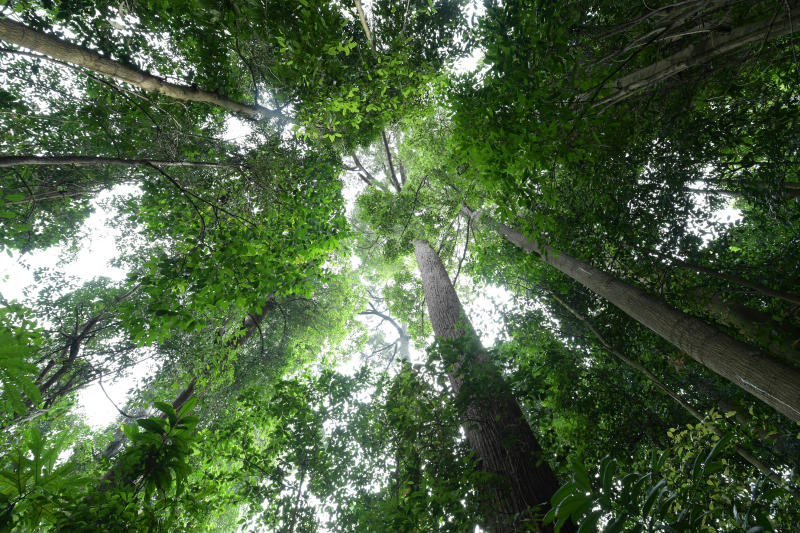Reforestation may not be a cheap climate fix; nature-based solution must consider trade-offs: Study
Sign up now: Get ST's newsletters delivered to your inbox

Reforestation has been touted as a relatively quick and easy fix for dealing with climate change.
PHOTO: ST FILE
Follow topic:
SINGAPORE - Reforestation has been touted as a relatively quick and easy fix for dealing with climate change, with plans afoot both in Singapore and around the world to harness the cooling and oxygen-giving power of the humble tree.
Indeed, planting trees may seem the cheaper option in tackling climate change when compared with alternatives such as developing technologies to reduce emissions (such as clean energy), or to convert the heat-trapping gases to other useful by-products (such as concrete).
But there are costs to reforestation as well, and having a better idea of the trade-offs to this nature-based climate solution could help policy makers better assess its effectiveness.
Now, a team of scientists, including researchers from Singapore, have for the first time mapped out just how much land can be reforested in South-east Asia after taking into account the trade-offs and financial constraints.
They found that while about 121 million hectares of land - an area almost five times the size of the United Kingdom - was suitable for reforestation in the region, this was reduced by between 50 and 87 per cent after accounting for financial constraints under three scenarios - low, moderate and high costs.
The low cost scenario included the direct costs, such as the need for constant site maintenance, as well as the investments made into protecting forests from illegal loggers, or fires.
The moderate and high cost scenarios also took into consideration "hidden" costs, such as how reforesting lands could compromise the livelihoods, food security and land rights of indigenous communities.
Many communities in South-east Asia live off their lands by planting crops for sustenance, as well as cash crops, such as oil palm, to sell to larger companies.
The study was published in the scientific journal Nature Climate Change on Monday evening Singapore time (Aug 17).
The study's lead author, Dr Zeng Yiwen, a post-doctoral fellow from the National University of Singapore (NUS), said the study had focused on South-east Asia as the region has the capacity to implement nature-based climate solutions on a large-scale.
"But it's also a region where there are many competing interests for the land, and we have to start thinking of ways to conserve forests and biodiversity that are practical, economically feasible, and socially inclusive," he told The Straits Times.
Dr Zeng added that the study had shown that even a moderate reduction in opportunity costs could almost double the climate mitigation potential of reforestation.
And while there is no one solution to reducing opportunity costs, solutions could include developing alternative incomes for farmers, or for countries to contribute to other financial mechanisms to protect forests, said Dr Zeng.
Reforestation has been gaining traction among policy-makers as a nature-based climate solution.
During the World Economic Forum in January this year, for example, a "one trillion tree" initiative was launched to urge governments, companies and grassroots organisations to plant new trees and avoid deforestation. It was seen as a nature-based solution for locking up carbon in the world's forests, grasslands and wetlands.

In March this year, Minister for National Development Desmond Lee said a million trees will be planted over the next decade along Singapore's roads and coasts, and in parks, estates and green areas.
Carbon dioxide, copious amounts of which are produced through human activities such as the burning of fossil fuels, is the main greenhouse gas driving global warming.
But trees have the unique ability to capture heat-trapping carbon dioxide in a process known as photosynthesis, which locks the carbon in tree biomass such as trunks and roots, and produces oxygen that nourishes all other living things on the planet.
NUS conservation scientist Koh Lian Pin, who supervised the research, said the study was the first to take a realistic look at reforestation in South-east Asia by considering such practical constraints.
Said Prof Koh, who helms the new NUS Centre for Nature-based Climate Solutions: "The study's key take-home message is that the theoretical benefit of reforestation, or any climate solution for that matter, needs to be tempered with a proper accounting of on-the-ground realities."
The costs of climate change on society is often quantified in financial terms.
For example, property values in low-lying coastal areas susceptible to sea level rise may dip, explained Prof Koh, and a climate-related increase in the risk and prevalence of human diseases could also result in higher medical expenses.
Governments need to be able to evaluate the relative financial costs of climate actions versus inaction to make informed decisions, said Prof Koh.
"At the local level, communities may also need to be compensated for giving up agriculture or other profitable use of the land for reforestation to happen."

